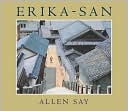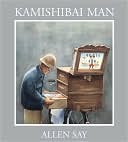Allen Say, Asian American author, was born James Allen Koichi Moriwaki Seii, in Yokohama, Japan on August 28, 1937, to a Japanese American mother and a Korean father. His first children's book, The Boy of the Three-Year Nap, was published in 1972. Since then, he has authored nearly a dozen more books! I hope you enjoy these historical-fiction picture books as much as I do!
 Say, Allen.
Say, Allen.Home of the Brave.
2002.
Houghton Mifflin Harcourt.
Summary from Barnes & Noble:
In dreamlike sequences, a man symbolically confronts the trauma of his family’s incarceration in the Japanese internment camps during World War II. This infamous event is made emotionally clear through his meeting a group of children all with strange name tags pinned to their coats. The man feels the helplessness of the children. Finally, desperately he releases the name tags like birds into the air to find their way home with the hope for a time when Americans will be seen as one people—not judged, mistrusted, or segregated because of their individual heritage.
I know this book is supposed to be symbolic of the feelings of the children incarcerated during World War II, but aside from that, I just wasn't able to make a connection... if any of you have read and are familiar with this book, please share your thoughts with me... reason with me! Help me to understand - I think it has the potential of being a quality piece of literature to share with children, but I need help in making sense of it myself before being able to successfully share it with children.
 Say, Allen.
Say, Allen.Erika-San.
2009.
Houghton Mifflin Harcourt.
Summary from Barnes & Noble:
In her grandmother’s house there is one Japanese print of a small house with lighted windows. Even as a small girl, Erika loved that picture. It will pull her through childhood, across vast oceans and modern cities, then into towns—older, quieter places—she has only ever dreamed about. But Erika cannot truly know what she will find there, among the rocky seacoasts, the rice paddies, the circle of mountains, and the class of children. For Erika-san, can Japan be all that she has imagined?
Allen Say is really starting to grow on me as an author. At first, I didn't really understand his work, but now, I'm slowly discovering the deeper meaning to be found within each book. This particular piece does a wonderful job sharing different aspects of the Japanese culture - in particular, the quieter Japan, opposite of the busy Tokyo. While I'm not sure that young children will understand the message conveyed here - there is great satisfaction to be found if you pursue your dreams, as it is conveyed by means of a "love story" of sorts. I think girls will be most apt to enjoy this particular Say work, but that's not say that boys won't find it equally interesting, especially if they're interested in learning about Japan.
 Say, Allen.
Say, Allen.Kamishibai Man.
2005.
Houghton Mifflin Harcourt.
Guided Reading Level: N
Summary from Barnes & Noble:
The Kamishibai man used to ride his bicycle into town where he would tell stories to the children and sell them candy, but gradually, fewer and fewer children came running at the sound of his clappers. They were all watching their new televisions instead. Finally, only one boy remained, and he had no money for candy. Years later, the Kamishibai man and his wife made another batch of candy, and he pedaled into town to tell one more story—his own. When he comes out of the reverie of his memories, he looks around to see he is surrounded by familiar faces—the children he used to entertain have returned, all grown up and more eager than ever to listen to his delightful tales.
Now this is one Allen Say story that I would certainly want to add to my bookshelf! Not only does the story depict old-Japan vs. new-Japan, it shares with children a bit of their culture that should never have been forgotten - the Kamishibai, or picture storytelling. I could almost picture myself using this with say a 4th or 5th grade classroom - presenting each children with a different picture and assigning them to write a story about the picture. Using the writing process - drafting, editing, publishing, I would then create the wooden box theater that holds the picture and ask each child to be the Kamishibai Boy or Girl and share their story with the class. I think this would make for a really neat writing activity!
If you're interested in finding out more information about any of the books reviewed or if you'd like to purchase the books, click the cover image for a link to Amazon.com.








1 comments:
Thanks for pointing out that this Allen Says birthday.
We are big fans of his stories and illustrations.
Have you read: Grandfather's Journey, Emma's Rug, Tea with Milk, Tree of Cranes, Bicycle Man? These are our favorites.
Post a Comment